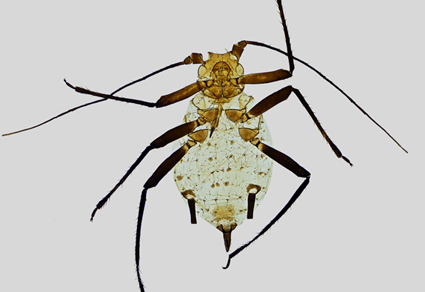Abstract
Here we present a description of a new aphid species from the subgenus Asterobium Hille Ris Lambers, 1938 of the genus Macrosiphoniella Del Guercio, 1911 in the tribe Macrosiphini Wilson, 1910 (Aphididae). The new species—Macrosiphiniella (Asterobium) herczeki sp. nov. living on Galatella villosa (Asteraceae) in Tolbuchin region, Bulgaria, is described based on apterous viviparous females. The new species is morphologically similar to M. (Asterobium) konyratica Kadyrbekov, 2018 from Kazakhstan from which it differs in several morphological and metric characters. We provided an updated key to “Blackman’s & Eastop” online key to Aster-feeding aphids.
References
- Blackman, R.L. & Eastop, V.F. (2023) Aphids on the World’s Plants: An Online Identification and Information Guide. Available from: http://www.aphidsonworldsplants.info (accessed 15 June 2023)
- Börner, C. (1939) Neue Gattungen und Arten der mitteleuropäischen Aphidenfauna. Arbeiten über physiologische und angewandte Entomologie aus Berlin-Dahlem, 6 (1), 75–83.
- Favret, C. (2023) Aphid species file. Version 5.0/5.0. Available from: http://Aphid.SpeciesFile.org (accessed 20 June 2023)
- Del Guercio, G. (1911) Intorno ad alcuni afididi della Penisola Iberica e do altre località. Redia, 7 (2), 296–333.
- Heie, O.E. (1995) The Aphidoidea of Fennoscandia and Denmark VI. Aphidinae. Part 3 of Macrosiphini and Lachnidae. Fauna entomologica scandinavica, 31, 1–222.
- Hille Ris Lambers, D. (1938) Contributions to a monograph of the Aphididae of Europe. 1. The genus Macrosiphoniella del Guercio, 1911, III. Temminckia, 1–47.
- Hille Ris Lambers, D. (1947) On some mainly western European aphids. Zoologische Mededeelingen, 28 (14), 291–333.
- Holman, J. (2009) Host plant catalog of aphids. Palaearctic region. Springer Science + Business Media B.V., Berlin, 1140 pp. https://doi.org/10.1007/978-1-4020-8286-3
- Ilharco, F.A. & van Harten, A. (1987) Systematics. In: Minks, A.K. & Harrewijn, P. (Eds.), Aphids: Their biology, natural enemies and control. Elsevier Science Publishers, Amsterdam, pp. 51–77.
- Kadyrbekov, R.Kh. (2018) Materials to subgenus Asterobium Hille Ris Lambers, 1938 of the genus Macrosiphoniella Del Guercio, 1911 (Hemiptera: Aphidoidea, Aphididae). Selevinia, 26, 9–14.
- Koch, C.L. (1855) Die Pflanzenläuse Aphiden getreu nach dem Leben abgebildet und beschrieben, 5, 135–166. https://doi.org/10.5962/bhl.title.77523
- Szelegiewicz, H. (1963) Aphididae (Homoptera) aus Vorderasien, samt Beschreibung einer neuen Untergattung und Art. Annales Zoologici, 21 (7), 53–60.
- Szelegiewicz, H. (1980) Aphids of the genus Macrosiphoniella del Guercio (Homoptera, Aphididae) from Korea. Annales Zoologici, 35, 419–473.
- Tao, C.C. (1963) Revision of Chinese Macrosiphinae (Aphidae, Homoptera). Plant Protection Bulletin (Taiwan), 5 (3), 162–205.
- Walker, F. (1849) Descriptions of Aphides. The Annals and Magazine of Natural History, Including Zoology, Botany, and Geology, Second Series, 3 (13), 43–53. https://doi.org/10.1080/03745485909494586
- WFO (2023) World Flora Online. Published on the Internet. Available from: http://www.worldfloraonline.org (accessed 16 June 2023)
- Wilson, H.F. (1910) A key to the genera of the subfamily Aphidinae and notes on synonymy. Annals of the Entomological Society of America, 3 (4), 314–325. https://doi.org/10.1093/aesa/3.4.314


